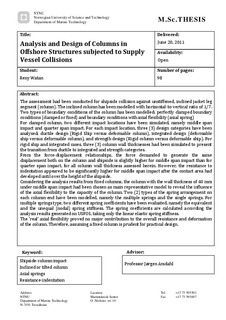| dc.description.abstract | The assessment had been conducted for shipside collision against unstiffened, inclined jacket leg segment (column). The inclined column has been modelled with horizontal-to-vertical ratio of 1/7. Two types of boundary conditions of the column has been modelled; perfectly clamped boundary conditions (clamped or fixed) and boundary conditions with axial flexibility (axial spring).
For clamped column, two different impact locations have been simulated, namely middle span impact and quarter span impact. For each impact location, three (3) design categories have been analysed; ductile design (Rigid Ship versus deformable column), integrated design (deformable ship versus deformable column), and strength design (Rigid column versus deformable ship). For rigid ship and integrated cases, three (3) column wall thicknesses had been simulated to present the transition from ductile to integrated and strength categories.
From the force-displacement relationships, the force demanded to generate the same displacement both on the column and shipside is slightly higher for middle span impact than for quarter span impact, for all column wall thickness assessed herein. However, the resistance to indentation appeared to be significantly higher for middle span impact after the contact area had developed until over the height of the shipside.
Considering the analysis results from fixed columns, the column with the wall thickness of 40 mm under middle span impact had been chosen as main representative model to reveal the influence of the axial flexibility to the capacity of the column. Two (2) types of the spring arrangement on each column-end have been modelled, namely the multiple springs and the single springs. For multiple springs type, two different spring coefficients have been evaluated, namely the equivalent and the unequal (nodal) spring stiffness. The spring coefficients are calculated according the analysis results generated on USFOS, taking only the linear elastic spring stiffness.
The ‘real’ axial flexibility proved no major contribution to the overall resistance and deformation of the column. Therefore, assuming a fixed column is prudent for practical design. | nb_NO |
